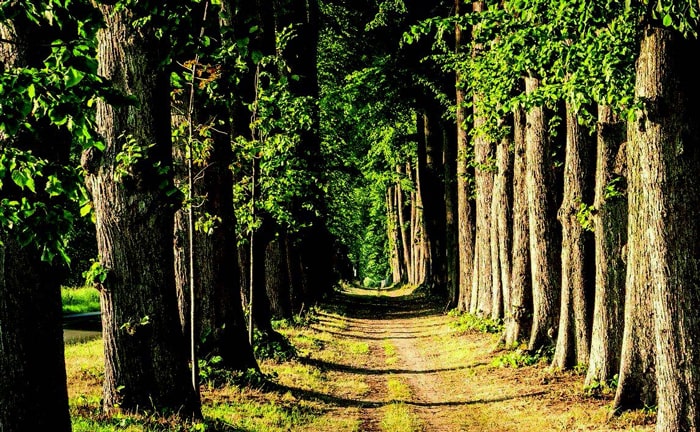The most striking evidence of the early gardens of the Borstel estate is the imposing avenue of linden trees planted around 1770, which runs from today's Bundesstraße 432 to the manor house and on to the former estate. The linden trees stand at a distance of 4 to 4.5 m in staggered stands with a distance between the rows of trees of also approx. 4 to 4.5 m.

Despite years of maintenance and pruning measures on the listed trees, some of the trees, which are over 250 years old, had to be felled in recent years. In some cases, the wood substance was so poor that the breakage and stability could no longer be guaranteed and there was an acute danger of the trees toppling over.
One reason for the instability of the trees was the infestation of two harmful fungi: the fire-crust fungus and the Hallimasch. Both are widespread in Germany and occur both in the forest and in park stands and attack various deciduous trees such as beech, lime, willow and poplar. The fire-crust fungus decomposes the central root area and the base of the trunk of the tree already in the early stage, without the tree showing signs of reduced vitality. As the fungus progresses, it causes intense white rot, and later musty rot, which can spread rapidly. As a result, the tree's stability is reduced to such an extent that it can topple without warning.
Together with the AktivRegion Alsterland, the company Fielmann, donations from the Förderverein am Forschungszentrum Borstel and EU funds, the Research Center Borstel, Leibniz Lung Center has already been able to replant many trees in recent years. In addition, a replanting concept for the sustainable development of the linden wreath of the cour d'honneur was developed in coordination with the monument protection authority and the nature conservation authority, so that this magnificent ensemble can be preserved in the future.
The linden avenue is under special protection, both as a cultural monument and as a natural monument and legally protected biotope.
Markantestes Zeugnis der frühen Gartenanlage des Gutes Borstel ist die imposante, um 1770 gepflanzte Linden-Allee, die von der heutigen Bundesstraße 432 bis zum Herrenhaus und weiter bis zum ehemaligen Gutshof verläuft. Die Linden stehen in einem Abstand von 4 bis 4,5 m in versetztem Stand mit einem Abstand zwischen den Baumreihen von ebenfalls ca. 4 bis 4,5 m.

Trotz jahrelanger Pflege- und Schnittmaßnahmen an den denkmalgeschützten Bäumen mussten in den letzten Jahren einige der über 250 Jahre alten Bäume gefällt werden. Die Holzsubstanz war teilweise so gering, dass die Bruch- und Standfestigkeit nicht mehr gewährleistet werden konnte und akute Umsturzgefahr bestand.
Ein Grund für die Instabilität der Bäume war der Befall von gleich zwei Schadpilzen: Dem Brandkrustenpilz und dem Hallimasch. Beide sind in Deutschland weit verbreitet und treten sowohl im Wald als auch in Parkbeständen auf und befallen verschiedene Laubgehölze, wie Buche, Linde, Weide oder Pappel. Der Brandkrustenpilz zersetzt bereits im frühen Stadium den zentralen Wurzelbereich und den Stammfuß des Baumes, ohne dass der Baum Anzeichen von verminderter Vitalität zeigt. Im weiteren Verlauf verursacht der Pilz eine intensive Weißfäule, später eine Moderfäule, die sich rasch ausbreiten kann. Die Folge: Die Stabilität des Baumes ist soweit herabgesetzt, dass dieser ohne Vorwarnung umstürzen kann.
Gemeinsam mit der AktivRegion Alsterland, dem Unternehmen Fielmann, Spendengeldern des Fördervereins am Forschungszentrum Borstel und EU-Mitteln konnte das Forschungszentrum Borstel, Leibniz Lungenzentrum in den letzten Jahren bereits viele Bäume neu pflanzen. Zudem wurde in Abstimmung mit der Denkmalschutzbehörde und der Naturschutzbehörde ein Nachpflanzungskonzept zur nachhaltigen Entwicklung des Lindenkranzes des Ehrenhofes entwickelt, damit dieses prachtvolle Ensemble auch in der Zukunft erhalten bleiben kann.
Die Lindenallee steht unter dem besonderem Schutz, sowohl als Kulturdenkmal als auch als Naturdenkmal und gesetzlich geschütztes Biotop.